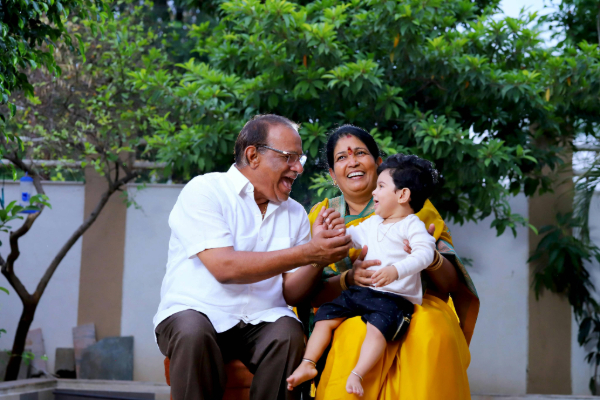India’s Aging Crisis: Emerging Markets Can’t Afford to Ignore Their Elders

Photo credit: Sagar Ahire.
Conversations about aging populations tend to focus on developed countries—Japan’s shrinking workforce, Europe’s pension pressures, America’s retirement boom. India, on the other hand, is celebrated for its young population—a strategic advantage, with the average age being more than 10 years younger than in most major economies.
A trip to India during winter break to visit grandparents left me wondering if India really is a rosy picture of youth.
India is aging rapidly. By 2050, older adults (aged 60 and older) are expected to make up nearly 20% of the population—roughly 320 million people. Between 2022 and 2050, the population aged 80 and above will grow 279 percent. Yet conversations about preparing for this demographic shift remain few and far between.
Emerging markets are unprepared
Emerging markets like India are facing an urgent challenge: Their populations are growing older and dependent while their systems remain nascent and under-resourced.
Social security systems in emerging markets are weak or nonexistent. Approximately 40 percent of individuals 60 and older across Asia and the Pacific lack access to pensions, forcing many to continue working past retirement age, predominantly in informal sectors without basic labor protections. This exacerbates the challenges of an aging population that has limited healthcare access and has to rely on family support for survival, which can be unsustainable and unevenly distributed.
In India, noncommunicable diseases (NCDs), i.e., diabetes, cancer, cardiovascular issues, and injuries, are responsible for 52 percent of fatalities. The burden of chronic diseases and age-related health conditions can strain healthcare systems, particularly in the absence of preventive care and long-term care options. NCDs are projected to cost India $4.3 trillion in productivity losses and healthcare costs between 2012 and 2030.
Other complexities further compound the issue; the 28 states of India have varying levels of development; two-thirds of the elderly population lives in rural areas; and half of them have poor socioeconomic status. Elderly women in India are nearly twice as likely as elderly men to have no income and face significantly less access to care than men have. Although more elderly women report poor health, men are hospitalized at higher rates (87 vs. 67 per 1,000), underscoring the gender divide.
Reliance on family support plays a crucial role in providing care for older adults in many emerging markets, often based on cultural traditions and norms. But this reliance on family can lead to social isolation, neglect, and abuse of older adults, especially when families are struggling financially or have limited time and resources. According to a report from the Asian Development Bank, 31 percent of elders in developing Asia and the Pacific report depressive symptoms owing to illness, social isolation, and economic insecurity. India also lacks sufficient legislation specific to elder abuse concerns. In 2007, Parliament passed the Maintenance and Welfare of Parents and Senior Citizens Act to ensure that younger generations provide for their aged relatives. Yet surveys reveal that most elders do not know their own rights and are culturally unlikely to take their families to court.
The economic consequences
India’s aging crisis carries economic consequences. Without foresight and reform, rising expenditures and shifting dependency ratios could undercut the very growth the country is counting on.
A dependency ratio reveals how many people are not in the workforce (because they’re too young or too old) compared to those in the working population per 100 people. According to Pew Research Center, old-age dependency will more than double by 2050, but total dependency will fall, owing to a reduction in child dependency (i.e., fewer children under 15 and more in the workforce). Fewer kids mean less education spending, which can ease budgets in the short-term. But seniors are more expensive over time: They need pensions, healthcare, and long-term care. So, while total dependency might go down, the nature of dependency in India is fundamentally changing—from schools and playgrounds to hospitals and eldercare.
A call to action
Preparing for an aging society demands economic foresight, investment in social equity, and building resilient infrastructures, starting with policy reform such as expanding pension systems, legislating elder abuse protections, and expanding healthcare to support geriatric and long-term care. Targeted investment in preventive health, insurance, and community care models will ensure that India transitions from being a reactive system to a resilient one. Drawing inspiration from Japan’s focus on “aging in place”—combining medical care, nursing, and housing in local communities to allow seniors to live independently for longer—India could give local governments and nongovernmental organizations the support they need to offer decentralized, community-based senior care.
Seniors are becoming a larger share of the consumer class, giving rise to the idea of a “silver economy,” the sum of economic activity serving the needs of people 50 and older, including both public and private expenditures. Tapping into the emerging silver economy with products for senior wellness, housing, and fintech inclusion is an exciting opportunity for emerging markets. This has already started in major Indian cities like Chennai, where companies are developing advanced senior living communities that offer healthcare, social engagement, and convenience. This not only improves the quality of life for seniors but also opens new market opportunities across various industries. Initiatives like International Finance Corp.’s Silver Economy Initiative, which aims to develop financial products and services tailored to older adults to promote economic inclusion, can serve as models.
Longevity is a sign of progress and reflects developmental success, but only if the elderly population lives with dignity and support.
About the author

Aarushi Jain, MBA ’25 is an Emerging Markets Institute Fellow. Before coming to the Samuel Curtis Johnson Graduate School of Management, Jain was a product marketer at a leading software-as-a-service company. During internships at global think tanks including the Council on Foreign Relations, Jain conducted public policy research.
All views expressed in articles published on the Emerging Markets Institute webpage are those of the author(s) and should not be taken as reflecting the views of the Emerging Markets Institute.
